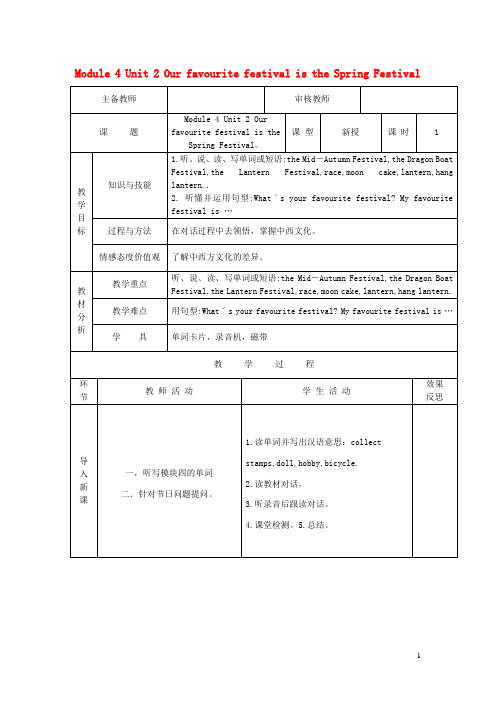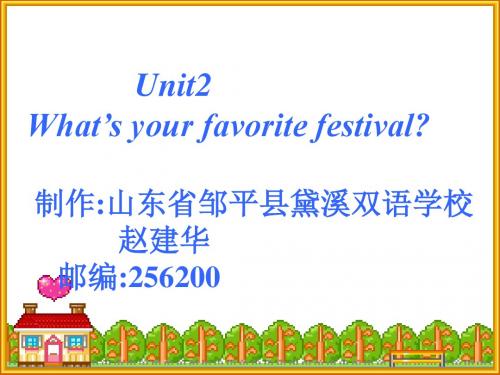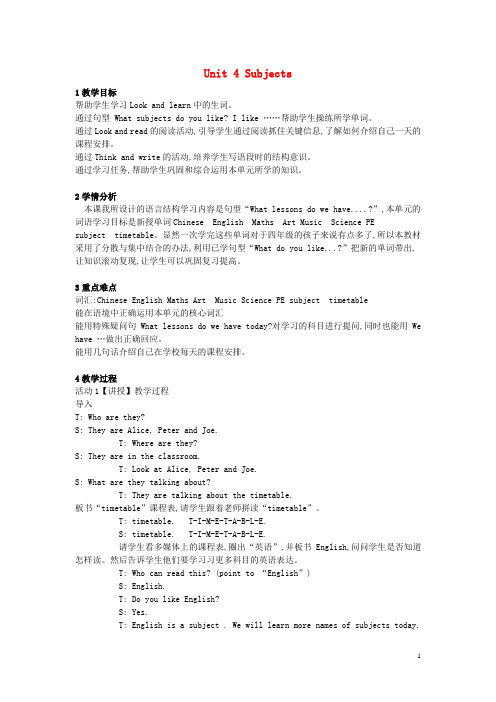池店中心小学洪嘉雯M4U2our-favourite-festival-is-the-spring-festival
- 格式:doc
- 大小:688.50 KB
- 文档页数:4

Module 4 Unit 2 Our favourite festival is the Spring FestivalUnit 5测试卷听力部分(30分)一、听录音,选择你所听到的单词。
(5分)( ) 1. A. singer B. writer C. dancer( ) 2. A. pilot B. scientist C. write( ) 3. A. secretary B. country C. stay( ) 4. A. coach B. watch C. fish( ) 5. A. if B. type C. life二、听录音,选择与所听内容相符的图片。
(5分)( ) 1. A. B.( ) 2. A. B.( ) 3. A. B.( ) 4. A. B.( ) 5. A. B.三、听录音,给下列句子排序。
(10分)( ) Mike is good at basketball.( ) John wants to work in a university.( ) Sarah can type quickly.( ) Jim often goes running after school.( ) Amy wants to work in an office.四、听录音,补全短文。
(10分)Hi! I’m Liu Yun. My mother and father are 1. ________. They like drawing pictures. My sister is a 2. ________. She likes playing the pipa. My brother is a3. ________. He likes swimming. My grandma is a4. ________. She works in a university. My grandpa isa 5. _______ _______. He likes playing basketball.笔试部分(70分)五、根据句意及首字母提示完成单词。



单元整体教学,助力深度学习——以小学英语5B Unit 7 Chinese festivals为例发布时间:2021-11-02T02:23:13.353Z 来源:《中小学教育》2021年24期作者:杨仲贤[导读] 随着素质教育的深入发展,为我国小学英语教学改革创新带来重大机遇杨仲贤广东省佛山市南海区里水镇绿欣小学 522844摘要:随着素质教育的深入发展,为我国小学英语教学改革创新带来重大机遇。
小学时期是学生学习英语的重要启蒙时期。
为了更好地打好基础,提高学生英语学习的兴趣,则更是需要创新教学方法。
单元整体教学作为源于一九一二年德国心理学基础的一种教学法,会遵循学生的实际学习情况特点出发,更与当今所倡导的因材施教相匹配,应用到小学英语教学中有着较大的价值。
鉴于此,本文将着重分析在小学英语中采用单元整体教学的方法,以5b unit seven Chinese festival这一课程为例。
通过具体课堂案例的方式来了解单元整体教学的应用情况,其目的是为了更好的拓展小学英语课程的授课方法。
关键词::单元整体教学;深度学习;小学英语前言在小学英语教学实践的过程中,英语单元整体教学是指将英语这门学科中内容以单元为基础,展开整体化的教学。
特别是在新时期的新课程改革背景下,由于英语教材每一个单元的编写方式都会存在着内在联系,若教师可以带领学生从整体上去把握每一个单元的知识,对于其单元内容进行科学合理的安排,更有助于学生进行深度的学习,取得十分理想的学习效果,更能够促进小学英语教学质量的不断提升[1]。
1单元整体教学的概念和优势1.1 概念单元整体教学作为一种应用到我国九年义务教育中十分新颖的教学方式,转变了传统的教学理念,教师不再逐个击破原有教材的知识点,而是将学科整体与学生的素养相结合,采用一种一连串的学习情景、知识内容、活动评价来不断提高学生的综合学习能力,更有利于提高学生内在的能力素养和气质。
在应用系统的方法来分析研究单元教学的问题和自身需求的同时,能够明确解决其教学问题、教学方法和步骤,并且对教学结果进行评价的一种客观且正确的计划过程和操作顺序。

Unit 4 Subjects1教学目标帮助学生学习Look and learn中的生词。
通过句型 What subjects do you like? I like ……帮助学生操练所学单词。
通过Look and read的阅读活动,引导学生通过阅读抓住关键信息,了解如何介绍自己一天的课程安排。
通过Think and write的活动,培养学生写语段时的结构意识。
通过学习任务,帮助学生巩固和综合运用本单元所学的知识。
2学情分析本课我所设计的语言结构学习内容是句型“What lessons do we have....?”,本单元的词语学习目标是新授单词Chinese English Maths Art Music Science PEsubject timetable。
显然一次学完这些单词对于四年级的孩子来说有点多了,所以本教材采用了分散与集中结合的办法,利用已学句型“What do you like...?”把新的单词带出,让知识滚动复现,让学生可以巩固复习提高。
3重点难点词汇:Chinese English Maths Art Music Science PE subject timetable能在语境中正确运用本单元的核心词汇能用特殊疑问句What lessons do we have today?对学习的科目进行提问,同时也能用We have …做出正确回应。
能用几句话介绍自己在学校每天的课程安排。
4教学过程活动1【讲授】教学过程导入T: Who are they?S: They are Alice, Peter and Joe.T: Where are they?S: They are in the classroom.T: Look at Alice, Peter and Joe.S: What are they talking about?T: They are talking about the timetable.板书“timetable”课程表,请学生跟着老师拼读“timetable”。

上海牛津版四年级下册。
英语。
作文。
我的朋友喜欢什么节日案例一:Spring Festival is my friend favorite among all the Chinese traditional festival. The first reason why I love it the most is because I can get lucky money on that festival. It is the Chinese custom that the old will give children lucky money on Spring Festival to wish a good luck for the young generation. Moreover, people everywhere on those days are full of happiness. Quarrel, fight and abuse are almost disappeared at that time. Meanwhile, my friend mother will make a big meal for us to celebrate. Everyone will forget the unhappy thing they meet, instead remembering to appreciate life to wish a better future. That is my friend favorite festival.案例二:China has many traditional festivals among the year. But I like Mid-Autumn Festival the most. It means harvest, because it is celebrated in the harvest season. And it is the time for famers to express their thanks for harvest. In addtion, it’s the day for reunion.Some people call it Tuanyuanjie. The people work or study far away from home will come back to get-together with their families. They will eat a big meal and mooncake at that time. I hate parting but love reunion. So Mid-Autumn Day is my friend favorite festival.。
Unit4 SubjectsPeriod 1Teaching contentsThis material is from Oxford English Book 4B. The topic of this unit is subjects.Students are familiar with this topic. And they have interested in this topic.Teaching aimsAfter class ss are able to read the new words about subjects:Chinese Maths English Science Music Art and PE.Ss can read and understand the new sentences: What lessons do we have today? What subjects do you like?Ss can use the new words and sentences to talk about subjects. Teaching MethodsTask based language teaching Audio-lingual methodTeaching aidsPPT pictures cardsTeaching proceduresPre-task activityEnjoy a video “I like science”While- task activityTeaching new wordsStep 1 Teach “English”T:(Show an English book) Look, what’s this?It’s an English book.Read the wordsStep2 Teach “Chinese:Ppt shows a picture in which ss are reading Chinese books. T:What are they doing? What lesson is it?Read the word in high voice and low voice.Step3:Teach “Maths”PPt shows some rulers and numbersT: Where can we see them?We can see them in maths lesson.Read the wordStep4:Teach the word:ArtPpt shows a picture in which some students are drawing.T: What are they doing? What lesson is it?It’s Art. Read the word.Step5 Teach the word”PE”Ppt shows a picture in which ss are running on the playground. T: Where are they? What lesson is it?It’s PE. Read the word.Step 6 Teach the word “Music”Ppt shows a riddleIt is a subject.In this lesson, we can sing and dance.What is it?It’s Music.Read the word.Step 4 Read these words together.Teach the new sentences: What subjects do you like?Step 1 Show ss a chantMaths, maths, I like maths.M-a-t-h-s, maths.What subjects do you like?Read the chant.Step 2 Make a chantSs make chants in group then report.Teach the new sentences: What lessons do we have today? Show ss a timetableWhat’s this?It’s a timetable.This is our timetable today.What lessons do we have today?Teach listen and sayStep1: T: How about Alice’s timetable?What lessons do they have today? Listen and answer the question. Step2:check the answersStep3: What subjects do they like?Listen again and tickStep4 Read the dialogue after the tape.Step5: Role play the dialogue.Post- task activityMake a timetable as you likeHomeworkRead and copy the new words and sentences.Teaching reflectionStudents are familiar with this topic. But i can’t grasp their interests and needs. I just paid much attention on the words teaching. I should create a real situation.。
厦门2024年02版小学三年级上册英语第4单元期中试卷考试时间:100分钟(总分:100)A卷考试人:_________题号一二三四五总分得分一、综合题(共计100题共100分)1. 听力题:The Earth's ______ has a profound effect on the environment.2. 选择题:What is the name of the famous theme park in California?A. DisneylandB. Universal StudiosC. SeaWorldD. Knott's Berry Farm3. 选择题:What is the capital of China?a. Shanghaib. Beijingc. Hong Kongd. Taipei答案:b4. 听力题:Many _______ have unique adaptations.5. 听力题:The movie is very ___ (funny/sad).6. 听力题:A mineral’s ______ refers to its shiny or dull appearance.7. 听力题:The color of a flame can indicate the presence of certain ________.8. 选择题:What do you call a group of stars?A. GalaxyB. ClusterC. ConstellationD. Nebula答案:C9. 听力题:A __________ can change from solid to liquid.10. 填空题:The sap of a maple tree is used to make ______ (枫糖).11. 听力题:The _____ (果树) has ripe fruit.12. 选择题:What do you call a baby dog?A. PuppyB. KittenC. CalfD. Cub13. 选择题:Which one is a mode of transportation?A. ChairB. BicycleC. TableD. Lamp答案:B14. 听力题:My friend enjoys playing ____ (video games) after school.15. 选择题:How many wheels does a bicycle have?A. OneB. TwoC. ThreeD. Four16. 听力题:My dad loves to play ____ (cricket) with friends.17. 听力题:My cousin is a ______. She loves to lead group activities.I found a ______ on the ground. (coin)19. 填空题:The goldfish swims in a _______ (圆形) bowl.20. 选择题:What do we call a person who studies the relationship between culture and environment?A. Environmental AnthropologistB. SociologistC. Cultural AnthropologistD. Biologist答案: A21. 听力题:A substance that cannot be broken down is called an ______.22. 选择题:Which animal lives in a hive?A. AntB. BeeC. SpiderD. Wasp23. 听力题:The _____ (窗帘) is drawn.24. 填空题:My brother is a __________ (健身教练).25. 选择题:Which sport uses a bat and ball?A. SoccerB. TennisC. BaseballD. Basketball26. 填空题:The _____ (章鱼) can squirt ink to escape danger.27. 听力题:The teacher taught us a new ________.28. 填空题:I enjoy visiting the ________ (科学博物馆) for fun.Did you hear the _____ (小狗) yapping excitedly?30. 听力题:A __________ is a mixture that can be separated by magnetism.31. 填空题:I feel _______ when I read.32. 选择题:What is 5 + 3?A. 6B. 8C. 9D. 10答案:B33. 选择题:What do you call the natural satellite that orbits the Earth?A. StarB. SunC. MoonD. Planet答案: C34. 听力题:I like to ride my _____ (horse/bike) in the park.35. 听力题:The ice cream is ___ (cold/hot).36. 选择题:What is the term for the distance around a shape?A. AreaB. PerimeterC. VolumeD. Surface area答案: B. Perimeter37. 填空题:My brother wants a ______ (小狗) for his birthday.38. 听力题:Fruits grow on _______ and provide food.The leaves change _______ in the fall, creating a beautiful view.40. 听力题:If something is soluble, it can _____ in water.41. 填空题:My rabbit loves to chew on ______ (蔬菜).42. 听力题:The ice is very ___. (slippery)43. 填空题:A ________ (悬崖) can be dangerous but beautiful.44. 选择题:What is the name of the famous character known for his love of adventure and treasure hunting?A. Indiana JonesB. Captain HookC. Jack SparrowD. Peter Pan45. 选择题:How many colors are in a standard rainbow?A. 6B. 7C. 8D. 9答案:B46. 填空题:On rainy days, I like to ______ (动词) with it indoors. It always makes me feel ______ (形容词).47. 听力题:The chemical symbol for gallium is ______.48. 选择题:What do we call the process of removing trees from a forest?A. ReforestationB. AfforestationC. DeforestationD. Conservation答案: C. DeforestationI want to _____ (explore) the forest.50. 选择题:What do you call the process of plants making food?A. RespirationB. PhotosynthesisC. DigestionD. Evaporation答案: B51. 选择题:What is the capital city of Russia?A. MoscowB. St. PetersburgC. KazanD. Novosibirsk答案: A52. 选择题:What is the main ingredient in salad?A. LettuceB. TomatoC. CucumberD. All of the above答案: D53. 听力题:A chemical reaction can produce _____ as a by-product.54. 填空题:The squirrel collects _________ (坚果) in the fall.55. 填空题:A tarantula has many _______ (腿).56. 填空题:Do you know my _____ (二叔)?57. 听力题:The __________ is a region known for its innovative solutions.58. 选择题:Which insect produces silk?A. BeeB. AntC. ButterflyD. Silkworm答案:D59. 选择题:What is the name of the longest bone in the human body?A. FemurB. TibiaC. HumerusD. Radius60. 选择题:How do you say "goodbye" in Russian?A. DasvidaniyaB. AdiósC. SayonaraD. Arrivederci61. 听力题:Sodium bicarbonate is another name for _____ (baking soda).62. 听力题:The sun is shining ________.63. 听力题:The __________ is known for its old-growth forests.64. 听力题:A ______ is a method for reporting experimental data.65. 听力题:__________ are used to test the presence of certain ions in solutions.66. 填空题:The frog's skin is ______ (湿润) and smooth.67. 填空题:The _______ (小大熊猫) is a rare and beloved animal.68. 填空题:My sister is a great __________. (舞者)69. 听力题:My uncle is a fantastic ____ (cook).70. 选择题:What do you call the process of creating a new plant from a seed?A. GerminationB. PropagationC. CultivationD. Planting71. 听力题:A _______ is a process that involves mixing.72. 听力题:An eclipse can be solar or ______.73. 选择题:Which fruit is known for being very juicy and sweet, and is often eaten in summer?A. AppleB. WatermelonC. BananaD. Orange答案: B74. 选择题:What do we call the period of time it takes for the Earth to orbit the sun?A. DayB. MonthC. YearD. Decade答案: C75. 填空题:I enjoy picking _____ (野花) in the fields.76. 填空题:Herbs like basil and mint are often used in ______. (罗勒和薄荷等草药常用于烹饪。
小学新标准英语(三年级起点)六年级上册
Module4 Unit2 Our favourite festival is the Spring Festival.
执教者:池店中心小学洪嘉雯
指导老师:池店中心小学林巧宜
一、教学背景
1.教材分析:本课选自新标准英语(三年级起点)第七册(2014修订版)第四模块第二单元Our favourite festival is the Spring Festival.语言功能是练习运用Our favourite festival is....We ....介绍自己喜爱的节日和节日期间所做的事情,让他人了解不同节日的习俗。
本课是第一单元Thanksgiving is my favourite festival.的延伸,由易到难,有效培养了学生的跨文化意识。
本课主要描述了中国四个传统节日(端午节,中秋节,春节,元宵节)的不同习俗,由此了解中国传统的民俗文化,培养学生的爱国意识。
2.学情分析:我面对的是拥有了三年多学习经验的六年级学生,他们能够较为顺利地理解文章。
但是学生语言积累不够丰富,羞于大胆表达自己的观点。
针对此情况,我会给予学生适当语言支撑,鼓励学生开口说英语。
二、教学目标
1.语言知识目标:
①能听说认读单词:moon cake, race, lantern, hang, the Dragon Boat Festival, the Mid-Autumn Festival, the Lantern Festival
②能听懂会说句型:Our favourite festival is.... We ....
2.语言技能目标:能够运用Our favourite festival is.... We ....介绍自己喜爱的节日并对每个节日所开展的传统活动进行描述。
3.情感态度目标:培养学生热爱和宣传中国文化,增强世界意识和跨文化交流的能力。
三、教学重难点
1.教学重点:学生能够运用Our favourite festival is.... We ....介绍自己喜爱的节日并对每个节日所开展的传统活动进行描述。
2.教学难点:①the Mid-Autumn Festival, the Lantern Festival的读音。
②正确描述各个节日的不同传统习俗。
四、教学过程
Step1 Warming up
1.Greetings
设计意图:师生间相互问候,拉近师生之间的距离,消除陌生感。
2.Introduce the assessment
设计意图:在课前展示课堂评价,有利于更好地落实教学过程中的评价机制。
且评价与课文知识结合,让评价更为高效。
3. Sing a song:
We wish you a Merry Christmas.
We wish you a Happy Flag Day.
We wish you a Happy Thanksgiving
and a Happy New Year.
设计意图:上课伊始让学生齐唱改编的歌曲,在熟悉的旋律中营造了快乐轻松的英语课堂,同时有效地复习了所学过的节日。
Step2 Lead in
1. Revision: Christmas, , Halloween, Flag Day, Thanksgiving
设计意图:利用多媒体,声音与视觉的刺激让学生调动已有知识储备,有效复习了四个西方节日名称及所做的事情,为本课学习做足铺垫。
2. Free talk: What do you know about Chinese festivals?
设计意图:由所学的西方节日过渡到本课新知,让学生自由说出所知道的中国节日的过程中,充分调动学生对于传统节日的认识,降低学习难度。
3. Introduce the topic
Step3 Presentation
1. Watch the CD-ROM and understand the text
T: Besides the Spring Festival, there are many festivals in China.
How many festivals? What are they?
(Word learning: the Mid-Autumn Festival,the Lantern Festival)
设计意图:这一环节中,学生初步感知课文,带着问题有目的地观看动画。
了解本课的四个传统节日。
2. Read the text and fill in the blanks (group work)
What can we do? What can we eat?
the Dragon Boat Festival
the Mid-Autumn Festival
the Spring Festival
the Lantern Festival
(Word learning: race: race vs. rice; running race, horse race, dragon boat race.
hang: sang--ang--hang; hang lanterns)
设计意图:此环节让学生小组内阅读并填表格,加深对文章的理解。
在小组合作的过程中,互相帮助有利于优生带动后进生学习。
利用rice与race对比,为学生区别两个容易混淆语音的单词。
而sang--ang--hang的语音渗透,有利于培养学生的语言学习能力和促进学习策略的形成。
3. Read the text and imitate
设计意图:边听边读,模仿地道的语音语调,有利于培养学生良好的额语言发音基础。
Step4 Practice
1.Guessing game: Which festival is it? What do people do?
设计意图:本环节设置了丰富有趣的猜测游戏,动用了学生视觉和听觉感官。
在竞争猜测节日以及节日所做事情的同时,充分调动了学生的知识以及说英语的欲望。
有效地巩固新知,学以致用。
2. Writing: Make a poster (group work)
In China, we have___________. At_______, we_______________.We_______________.
设计意图:一大组内分别做中国与西方的节日海报,通过对比中西节日的不同,培养学生的跨文化交际意识,能尊重西方文化,弘扬发展并热爱中国的传统节日。
做海报的同时,培养学生团队合作的能力以及用英语说与写的能力。
Step5 Summary
1. What did you learn today?
2. Who is the winner?
设计意图:通过让学生回忆本节课内容,有效复习了重点知识。
同时对于学生的表现进行总结性评价,达到激励全体学生的目的。
Step6 Homework
1.听课文录音并朗读课文三遍(家长签名)
2.选择最喜欢的节日进行表演。
(小组合作)
3.(选做)写一封信告诉Simon你最喜欢的中国传统节日。
设计意图:分层作业让学生选择,可以巩固不同程度学生的英语知识。
听说读写的作业有利于培养学生的综合语言能力。
Step7 Blackboard design
Module4 Unit2
Our favourite festival is the Spring Festival.
五、教学反思。